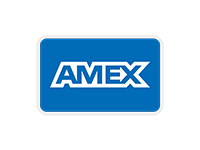
Introduction
The Canadian Pacific Railway’s Royal Hudson has been rightly described as one of the most successful locomotive designs of all time. These sleek machines were perhaps Canadian Pacific's most well know and visually impressive steam locomotives and this, together with their dependable performance over extraordinary distances, has ensured a lasting regard for these locomotives. Thanks to their smooth operating characteristics, engine crews considered these engines the most popular steam power the CPR ever had. To many railfans, the Royal Hudsons (along with the Selkirks) were a fitting closure to CP's long and glorious steam era.
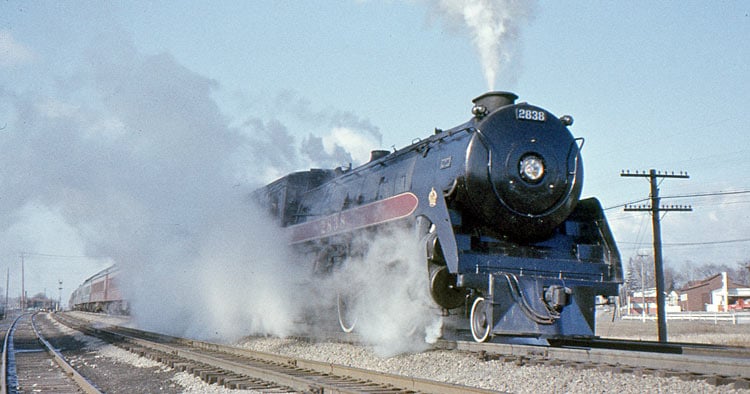
H1c Hudson #2838 at Oakville on April 15, 1957. Photo courtesy John Riddell.
The Genesis of a Classic
During the 1920s, the Canadian Pacific utilized their fleet of 4-6-2 Pacific locomotives for their long distance and heavier passenger trains. As train weights and lengths increased, the need for more horsepower was becoming obvious. In addition, the need for efficient and consistent high speed performance was more important than ever on high traffic routes like the Toronto - Montreal run.
H. B. Bowen, the Chief of Motive Power and Rolling Stock for the Canadian Pacific Railway from 1928 to 1949, realized that this would require the railway to invest in entirely new and modern locomotives.
Bowen’s first project were the huge T1a Selkirks (2-10-4) built by Montreal Locomotive Works. Bowen then set his mind to the passenger train problem. The CPR’s chief rival, the newly created Canadian National Railways, had committed itself to 4-8-4 Northerns for their heavy freight and passenger needs. The CPR built two Northerns (3100 and 3101) that were some 75,000 lbs. larger than the CNR units, but soon found them unsuitable for use on the CPR’s main line. Although some thought was given to designing a “lighter” Northern, Bowen and his team quickly came to the conclusion that a lighter 4-8-4 capable of meeting the speed and tractive effort needs of the railway wasn’t a practical option.
Bowen decided on the 4-6-4 Hudson design. Bowen had been quick to note the success of the New York Central's new Class J1a 4-6-4s in high speed passenger service in 1927. NYC named the 4-6-4 class 'Hudson' after its route along the Hudson River. The initial CPR design (H1a) was a substantial improvement over their G3 and G4 Pacifics. The addition of a two axle trailing truck allowed the designers to increase the grate size by 25% and obtain 275 lbs. boiler pressure. By utilizing an Elesco feed water heater and Type E super heaters, the new locomotive had steam capacity to spare. The new locomotives would feature 75” drivers and came in at a weight of 194,000 lbs., producing a tractive effort of 45,000 lbs.
The H1a Hudsons were delivered in 1929 during a period that saw the CPR endure the financial downturn of the early thirties. Despite this, the CPR purchased a second order of ten Hudsons (H1b’s) in 1930. Two units (2811 and 2819) were equipped with trailing truck boosters which gave them an additional 12,000 lbs. of tractive effort. Originally intended to assist heavy passenger trains through the Rocky Mountain range, the booster equipped H1b’s were essentially equal to the CNR’s Northerns (albeit with a higher axle loading), but with one fewer set of drivers to maintain.
The Depression brought a virtual halt to new locomotive production, but Bowen was planning for the day when the economic conditions would permit new construction. In 1937, the economic conditions were improving and the resulting improvement in CPR passenger traffic saw locomotive construction begin again. Bowen ordered 30 new Hudsons. These were the H1c, "semi-streamlined" 4-6-4 Hudson type locomotives that would soon become know world wide as the “Royal Hudsons”.
Royal Hudson classes
The Montreal Locomotive Works built the Royal Hudson locomotives in three batches: 2820 to 2849 (class H1c) in September-December 1937, 2850 to 2859 (class H1d) in August 1938 and 2860 to 2864 (class H1e) in June 1940.
Locomotives 2820 to 2859 were all coal-fired, while 2860 to 2864 were oil-fired and intended for operation between Vancouver and Revelstoke. Eventually, 16 of the coal-burning locomotives were converted to burn oil. Unlike the earlier class H1c and H1d locos, the five class H1e locomotives were delivered new in 1940 as Royal Hudsons with painted cast brass crowns affixed to their running board skirts.
Design features
The Royal Hudsons featured one-piece steel castings consisting of the locomotive frame, the cylinders and valve chests, steam pipes, and smoke box saddle, all as a single component. The locomotives featured a smooth boiler jacket enclosing many of the usual external boiler fittings, a cowled teardrop-shaped stack with two number boards, a recessed headlight and a solid pilot. Like the H1a’s and H1 b’s, they had a large enclosed cab and 75-inch diameter drivers that provided 45,300 lbs. of tractive effort. They were fitted with Walschaerts valve gear and Elesco feedwater heaters. Their tenders had a capacity of 12,000 Imperial gallons of water, 21 tons of coal (or 4,100 Imperial gallons of oil) and rode on six-wheel trucks with 36-inch diameter wheels. The engine weight was 324,000 lbs. while the tender weight was 133,000 lbs.
All locomotives had pilot trucks with 33-inch diameter wheels and roller bearings. With its four wheel engine and idler trucks, it proved to be a most stable design. The overall length over couplers was 90'-10". The wheel base of the tender was 28'-11". The locomotives had 22 X 30 inch cylinders and each locomotive cost the CPR $128,870.
All of the CPR Hudsons, including the H1c’s, d’s and e’s were built with Type E super heaters and Elesco feedwater heaters. The feedwater heater was devised to recover some of the wasted energy contained in the exhaust system by raising the temperature of the feed water prior to its being pumped into the boiler. This increased the steam raising capabilities of the boiler and at the same time reduced fuel consumption so that the thermal efficiency of the locomotive increased by approximately 8%. Just below the teardrop-shaped classification lights at the front were bulges in the boiler jacket concealing the ends of the Elesco feedwater heater.
The feedwater heater pump was mounted below the numbers on the running board on the left side of the locomotive, while the Westinghouse air pump was mounted in the same position on the right side. The following fifteen Royal Hudsons had a Franklin trailing truck booster engine: H1c (2838-2842), H1d (2850-2854) and H1e (2860-2864). The booster engine provided an additional 12,000 lbs. tractive effort to the locomotive’s 45,300 lbs. of tractive effort.
All coal-burning Royal Hudsons had a fire box grate area of 80 square feet, which was beyond the capability of a fireman and his shovel. As such, they were equipped by the Standard Stoker Company with Model BK mechanical stokers, which moved the coal from the tender to the firebox by means of a horizontal screw conveyor powered by a two-cylinder steam engine mounted on the locomotive's tender. Although this coal-fired system worked well, increasing oil production in Alberta and a surplus of residual fuel oil from western refineries made it economical to convert 16 coal-fired Royal Hudson’s to oil-firing at Weston Shops, Winnipeg, between July 1949 and February 1950. Conversion was relatively simple involving the replacement of the firebox grate with a brick lined fire pan, the removal of the mechanical stoker, the fitting of the necessary pipes and burner and the insertion of an oil tank in the tender’s original coal space.
.jpg)
Originally fired with coal by a standard BK mechanical stoker, the class H1c Hudsons 2829-2837 and 2843-2849 were converted to burn Bunker C oil. This eliminated the need of a mid-division coaling stop. Taking on coal was a very dirty job as some coal dust always got into the cab and, after conversion to oil-firing, the spacious, comfortable cab could be kept spotlessly clean. The fire in an oil burning locomotive could be better controlled than in a coal burner. The tenders of the converted locos were rebuilt to carry oil.
Some of the other Royal Hudsons converted to oil were: 2830, 2831, 2834, 2835, 2844, 2847, 2848 and 2853.
Variations
The Royal Hudsons featured three different styles of stacks. Originally the locos had their stacks enclosed in a streamlined teardrop-shaped cowling with a glass-covered number board on each side.
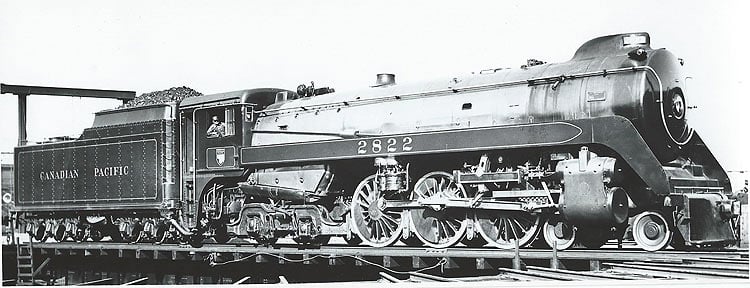
2822 with the original "teardrop" stack design with integral numberboards.
During later shopping many locos had their original teardrop-shaped cowling removed and replaced with an inverted bathtub-shaped cowling, minus the number boards.
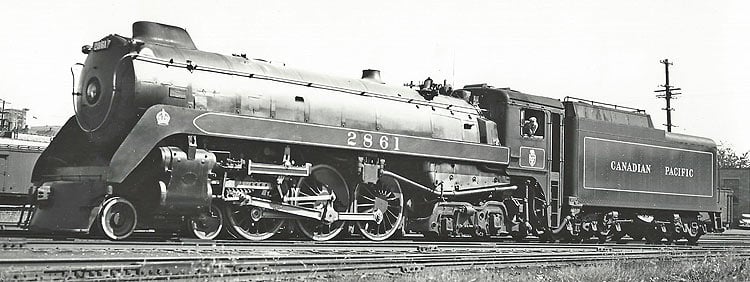
2861 with the intermediate "teardrop" stack design without numberboards.
In time, it was found that the exhaust from the original stack tended to obscure the engineer's view when working with a light throttle. After the war, most locos had their original teardrop-shaped stack replaced with an elongated straight stack casting with a top flange. At the front was the exhaust stack, while hidden behind in the shroud was the whistle. Although the casting appeared to be a double stack, all Hudsons had a single stack.

2831 with the final stack design.
Forty of the locos (classes H1c and H1d 2820-2859) were built with coal tenders as shown on 2822 above. Five locos (class H1e 2860-2864) were built with oil tenders.
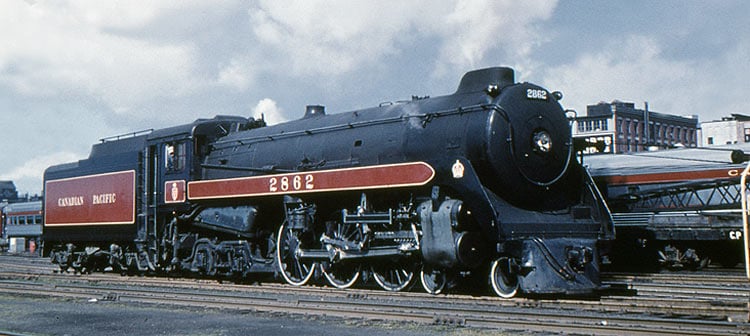
2862 with oil tender.
Two types of tender trucks were employed. Forty locos were built with six-wheel Commonwealth tender trucks as shown on 2829 below.

2829 showing its Commonwealth tender trucks.
The five oil burning locos (class H1e 2860-2864) were built with six-wheel Buckeye tender trucks.
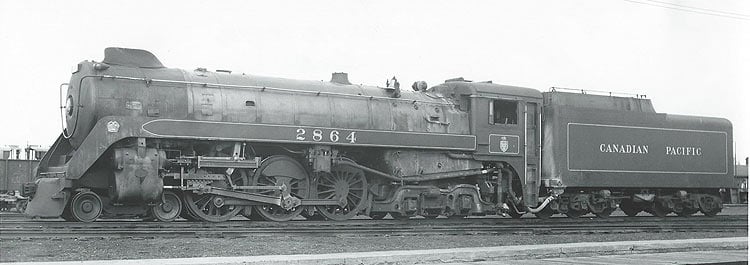
2864 with oil tender and Buckeye tender trucks.
Assignments
The Royal Hudsons represented the last great modern steam technology on the CPR and were assigned to the highest profile passenger service roles, usually on the transcontinental trains. The locations where the Royal Hudsons were assigned changed over the years. On December 31, 1952 they were assigned as follows: Montreal had ten (2820-2828, 2857), Toronto had seven (2838-2842, 2855-2856), Fort William had four (2850-2851, 2853-2854), Winnipeg had 17 (2829-2837, 2843-2849, 2852), Calgary had two (2858-2859) and Vancouver had five (2860-2864).
In later years, there were some reassignments. In the late 1950s Toronto had 2825-2842 and 2855-2858; Montreal had 2820-2825; Winnipeg had 2843-2849 and Calgary had 2834 and 2835.
H1c Hudsons were in the mainline passenger pool for the Winnipeg-Calgary service from their introduction in 1937-1938 until they were replaced by diesels.
Royal Hudsons regularly handled passenger and freight trains with equal facility and saw service on all CPR main lines with the exception of Montreal to Saint John, NB. While they were tried out on this route for a short time, it was considered inadvisable to assign them to this eastern route regularly due to bridge weight restrictions.
Royal Hudsons became responsible for almost all transcontinental passenger trains. A Royal Hudson would haul the Dominion 811 miles from Toronto to Fort William and another Royal Hudson would take the train 1,250 miles to Calgary without change. A Selkirk would be used between Calgary and Revelstoke and one of the H1e Royal Hudsons would take the train on its final 379 miles to Vancouver.
By late 1956, with the continual arrival of new diesel locomotives, most Royal Hudsons were downgraded from passenger to freight service and commuter service. With a high axle loading (64,000 lbs.), the Royal Hudsons were also ideal for “fast freight” service and their service lives were extended by several years in this role. By 1960, all of the 45 Royal Hudsons had been retired as Canadian Pacific had completed their conversion to diesel electric locomotives.
Livery
The Royal Hudsons were painted in standard CPR passenger livery: gray boiler; glossy black smoke box, running gear, cab and tender; tuscan red running board panels, cab doors, rectangular panel on cab sides and on tender sides; lettering in gold leaf; three-quarter inch gold striping around tuscan red panels on tender; half- inch gold striping around tuscan red panels on cab sides; and gray driving wheel tires.
Prior to 1946, the tuscan panel on the cab sides carried the CPR corporate shield without a beaver, instead having the white globe containing the words “WORLD'S GREATEST TRAVEL SYSTEM”.
Starting in 1946, a new shield was applied with a brown beaver sitting on the shield eating a tree branch with the wording “Canadian Pacific” in script above a globe stating “SPANS THE WORLD”. As it became evident that the days of steam were numbered on the Canadian Pacific, it was not uncommon to see a Royal Hudson missing its crowns. “Collectors” targeted the prized crowns and many of the locomotives went to the scrapers line bereft of their distinctive royal cipher.
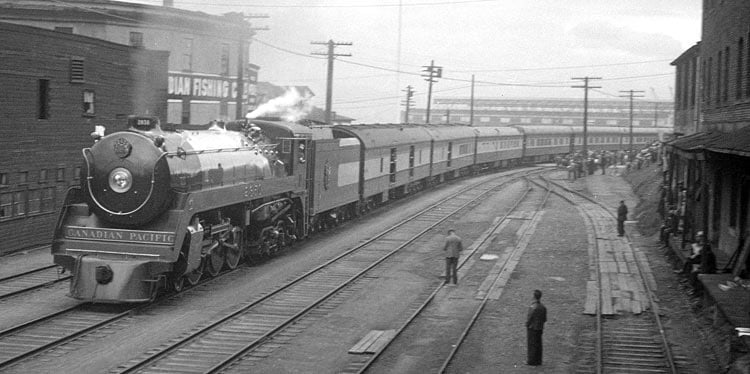
Royal Hudson #2850 (class H1d) on the 1939 Royal Train. Photograph by Walter E. Frost. City of Vancouver Archives collection.
The 1939 Royal Train
In 1939, Their Majesties King George VI and Queen Elizabeth made a 31-day tour of Canada by rail - the first visit of a reigning monarch to Canada. For the accommodation of Their Majesties, a special twelve-car Royal Train was made up. The tour used CPR lines westbound and CNR lines eastbound. CPR H1d 2850 - only five months old at the time - was selected to haul the Royal Train westbound across Canada over the Canadian Pacific portion of Their Majesties' tour.
For this unique service, 2850's tender, cab sides and running boards were repainted royal blue and the smokebox was painted black. Aluminum panels were run half way along the tender sides to blend with the side panels on the following twelve cars. The boilers and cylinders were polished stainless steel. The running gear and underbody details, including the frame, were finished in deep midnight (royal>..?) blue. The locomotive was fitted with a Royal Arms cast in relief above the headlight, four-foot high Royal Arms in relief on the tender sides and Imperial Crowns mounted on the side running board sheathing above the cylinders. The CPR shield with white globe containing the words “WORLD"S GREATEST TRAVEL SYSTEM” was on the cab sides. Polished cast brass numerals “2850” were mounted on the running board tuscan red panels. The driving rods were polished.
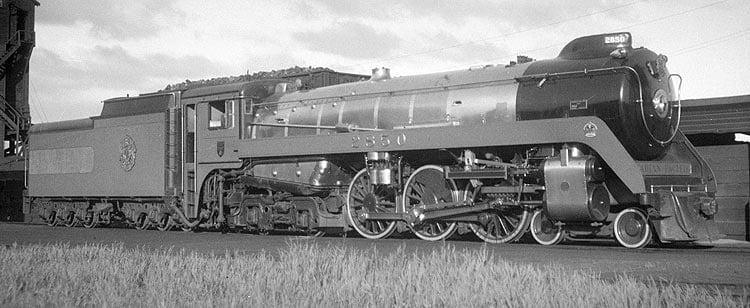
Photograph by Walter E. Frost. City of Vancouver Archives collection.
A pilot train powered by 2851 preceded the Royal Train by one hour. Locomotive 2851 carried similar royal crowns on its running boards, but otherwise carried the standard CPR tuscan red passenger paint scheme. 2850 and 2851 established records for length of assignment, remaining at the heads of their respective trains for the majority of the 3,224 mile trip without any delays or mechanical trouble of any kind. The CPR Royal Train ran from Quebec City to Vancouver by way of Montreal, Ottawa, Toronto, Winnipeg, Regina, Calgary and Kamloops. 2850 was precluded from use from Quebec City to Montreal due to lighter track.
Manned by 25 different engine crews on its cross-Canada trip, 2850 performed flawlessly. The Royal couple was impressed that a single steam locomotive could handle their train such a distance without engine changes. The King, somewhat of a rail buff, rode in the cab when possible and was very impressed with the performance of 2850 and her class. Following the Royal tour, at the urging of Bowen, the Canadian Pacific Railway applied for and was granted permission to designate all its semi-streamlined Hudsons as "Royal", with permission from the Royal family for the engines to wear the Royal family crown on their running boards. This was the first, and only time a locomotive outside of the United Kingdom was given royal status by the reigning monarch. Later that summer, 2850, still in its Royal Train paint scheme, was sent to represent Canadian Pacific in the pageant "Railroads on Parade" at the 1939 New York World's Fair. On its return, 2850 was repainted in standard passenger livery but retained its stainless-steel jackets, grab irons and royal crowns on its running boards. It was placed in service between Fort William and Winnipeg. Similarly, 2851 retained the royal crowns on its running boards.
Where Are They Now
Most Royal Hudsons were scrapped between 1958 and 1966. However, four Royal Hudsons have been preserved.
- 2850, the locomotive that hauled the Royal Train, served a long career until 1960, when she was retired and is now preserved and displayed at Exporail (formerly the Canadian Railway Museum) at Delson/Saint Constant, Quebec.
- 2858 is preserved and displayed in the Canada Science and Technology Museum in Ottawa.
- 2860 is preserved and displayed under cover at the West Coast Railway Heritage Park at Squamish, B.C.
- 2839 operated in the 1970s and 1980s and is now displayed outside at the Nethercutt Collection and Museum, Sylmar, California.
The BC Rail “Royal Hudson” - 2860
Royal Hudson 2860 was retired from active service in April 1956 after almost 16 years of service. She was withdrawn at Winnipeg and languished outside Weston Shops until August 1964 when she was acquired by the Vancouver Railway Museum Association for preservation. The project failed and she was acquired by the Province of British Columbia to operate summer season steam excursions between North Vancouver and Squamish. Before this was possible, a complete overhaul was necessary and the locomotive was rehabilitated at CPR's Drake Street Shops in Vancouver before returning to traffic on June 20, 1974. 2860 was completely restored to closely resemble the Royal engine 2850 except that there is an aluminum plaque on the pilot reading “BRITISH COLUMBIA” where 2850 carried a “CANADIAN PACIFIC” plaque in 1939. On each cab side is a small plaque reading “ROYAL HUDSON” and on the smokebox front is the British Columbia coat-of-arms where 2850 carried the Canada coat-of-arms. It also carries the British Columbia coat-of-arms on each tender side. 2860 was operated by the British Columbia Department of Travel and Industry with the cooperation of the British Columbia Railway.
The BCR commenced a Royal Hudson excursion service between North Vancouver and Squamish on 20 June 1974. By the end of the 1974 tourist season, 47,295 passengers had been carried and the excursion program was deemed successful. It was the only regularly scheduled steam excursion over mainline trackage in North America. The excursion operated between May and October, from Wednesday through Saturday, for 25 years until 1999. 2860 also toured North America in the late 1970s to promote BC tourism. It quickly became one of British Columbia's main tourist attractions and an icon of Canadian steam power. For its 1978 Canadian tour, 2860 received a thorough overhaul and the train left Vancouver on its 7,500 mile trip on March 30, 1978. After the election of the BC Liberal Government in 2001, all passenger services were gradually phased out starting with the Royal Hudson excursions. Currently 2860 is still owned by the British Columbia government, but is on permanent loan to the West Coast Railway Association (WCRA) and is housed securely under cover at the West Coast Railway Heritage Park in Squamish, B.C. The locomotive boiler has been rebuilt with the plan to resume specialty rail tours.
Royal Hudson 2839 - Southern Railway Royalty
2839 was one of the final Royal Hudsons to be decommissioned; officially not being struck off strength until March 1963. There were plans to send the locomotive to several proposed locations in Eastern Canada but these never materialized and the locomotive ended up in the United States with a very uncertain future. In 1979 the Southern Railway, who had a reputation for operating a very active steam excursion program leased 2839 and brought her back to operating condition.
The classic Canadian Pacific Tuscan colours still adorned her sides as she began service in September 1979 but the word “Southern” now replacing the Canadian Pacific name on the tender and a plate proclaiming the new operators name was placed on the pilot where the Canadian Pacific plate had once sat on 2850 during the 1939 Royal tour. 2839 ran numerous excursion trips for the Southern Railway from locations such as Cincinnati, Ohio and Lexington, Ky. and even ran a special on the rails of the former C&O and Clinchfield Railway before ending her service in late 1980 on a run from Salisbury to Ashville to celebrate the 100th anniversary of passenger service on that line.
2839 ended up being stored in Pennsylvania and then sent to the Blue Mountain & Reading Railway before being sold to the Nethercutt Collection and Museum in Sylmar, California where she sits on display, repainted in her Canadian Pacific colours.
The Legacy of the Royal Hudson
The last assignment of a CPR Royal Hudson took place on June 5, 1960, when 2857 headed up an Upper Canada Railway Society tour from Toronto to Port McNicoll and back. In June 1967, 2850, the very last Royal Hudson to be painted and serviced by Canadian Pacific, was sent to the National Museum in Ottawa. The days of the Royal Hudsons were over. Yet, over 55 years later, the Royal Hudson is still a well-known locomotive. Henry Bowen’s beautiful semi streamlined design, the service of 2850 during the 1939 Royal Visit, the legacy of reliable service and the Royal Hudsons’ length of service have all combined to make Canadian Pacific’s H1c - H1e series of Hudson locomotives a unique and everlasting part of Canadian railway history.


